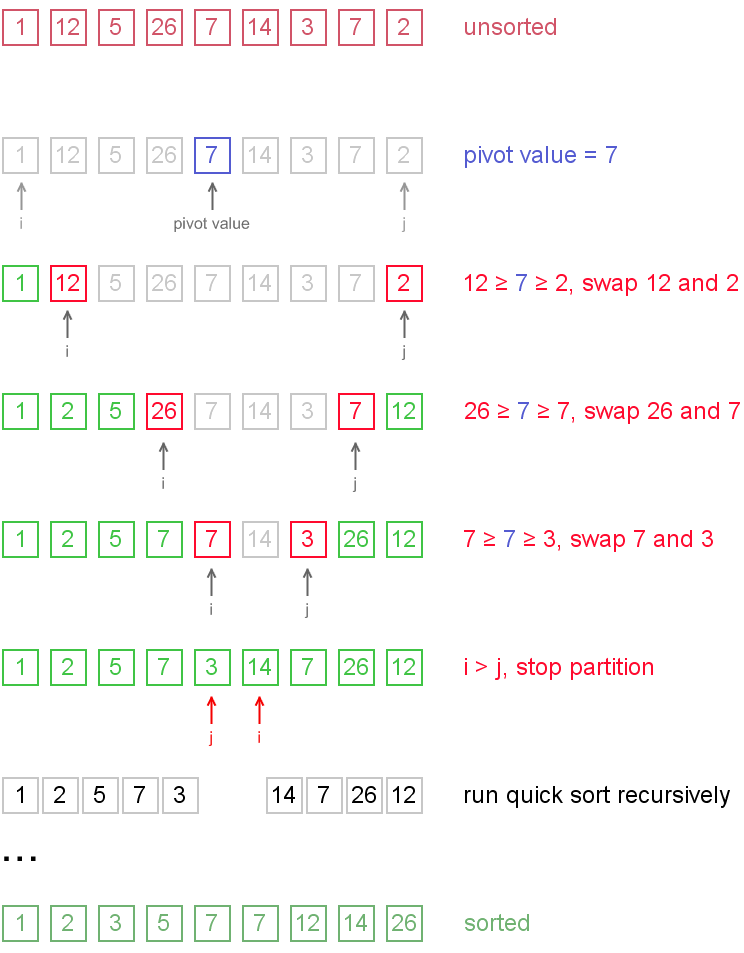[ACE] Quick Sort
QuickSort
In Merge Sort, the ‘divide’ is simple and the ‘merge’ is relatively complicated.
Can we make the ‘merge’ simple? Yes, and to make ‘merge’ becomes concatenate.
Concept
Quick-sort is a randomized sorting algorithm based on the divide-and-conquer paradigm:- Divide: pick a random element x (called pivot) and partition S into L(elements less than x), E(elements equal to x) and G(elements greater than x)
- Recur: sort L and G
- Conquer: join L, E and G

implement using Java
import java.util.Arrays;
public class QuickSort {
public static void main(String[] args) {
int [] a = {5, 2, 4, 7, 1, 3, 2, 6};
quick_sort_v1(a, 0, a.length-1);
System.out.println(Arrays.toString(a));
quick_sort_v2(a, 0, a.length-1);
System.out.println(Arrays.toString(a));
}
/*
* This version of quick_sort is recursively copy the value of i to j then copy j to i.
*/
public static void quick_sort_v1(int a[], int l, int r){
int i, j, x;
if(l < r){
i = l;
j = r;
x = a[i];
while(i < j){
while(i < j && a[j] > x){
j--;
}
if(i < j){
a[i++] = a[j];
}
while(i < j && a[i] < x){
i++;
}
if(i < j){
a[j--] = a[i];
}
}
a[i] = x;
quick_sort_v1(a, l, i-1);
quick_sort_v1(a, i+1, r);
}
}
/*
* This version of quick sort is to swap i and j;
*/
public static void quick_sort_v2(int[] arr, int low, int high) {
if (arr == null || arr.length == 0)
return;
if (low >= high)
return;
// pick the pivot
int middle = low + (high - low) / 2;
int pivot = arr[middle];//random number
// Partition: make left < pivot and right > pivot
int i = low, j = high;
while (i <= j) {
while (arr[i] < pivot) {
i++;
}
while (arr[j] > pivot) {
j--;
}
if (i <= j) {
int temp = arr[i];
arr[i] = arr[j];
arr[j] = temp;
i++;
j--;
}
}
// recursively sort two sub parts
if (low < j)
quick_sort_v2(arr, low, j);
if (high > i)
quick_sort_v2(arr, i, high);
}
}
analysis
As what we did in merge sort, we create a quick-sort tree. However, due to the different situation in quick sort, the tree will not always be a perfect binary tree but a normal binary tree.
As for running time, we need to discuss in different cases:
Worst-case running time:
The worst case for quick-sort occurs when the pivot is the unique minimum or maximum elementBest-case running time:
One of L and G has size n-1 and the other has size 0
The runing time is proportional to the sum n+ (n-1) + …+ 2+ 1
Thus, the worst-case running time of quick-sort is O(n^2)
The best case for quick sort occurs when the pivot is the median elementAverge-case running time
The L and G parts are equal- the sequence is split in halves like in merge sort
Thus, the best-case running time of quick-sort is O(n log n)
The average case for quick-sort: half of the times, the pivot is roughly in the middle.The stability? Again, it is depends on how you implement it.
Thus, the averge-case running time is O(n logn) again

Comparison sorting
A sorting algorithm is a comparison sorting algorithm if it uses comparisons between elements in the sequence to determine in which order to place them- Examples of comparison sorts: bubble sort, selection sort, insertion sort, heap sort, merge sort, quicksort.
- Example of not a comparison sort: bucket sort (Ch. 11.4). Runs in O(n), relies on knowing the range of values in the sequence (e.g. integers between 1 and 1000).
What is bucket sort?
It works by distributing the elements of an array into a number of buckets. Then output as the buckets sequence which has O(n)
Think about the comparison sorting to a binary decision tree.

And for n numbers, there will be n! possibilities.
If a binary tree has n! leaves, than the minimal number of levels( assuming the tree is perfect) is (log2 n!)+1
It has the same growth rate as nlog2 n
Thus, comparison-based sorting cannot do better than O(n log n)
评论
发表评论